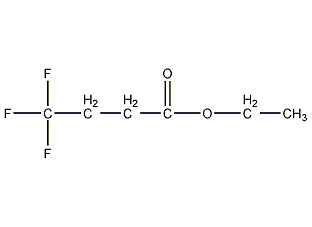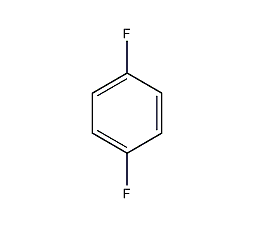4,4,4-Trifluorobutyric acid ethyl ester


Structural formula
| Business number | 04HR |
|---|---|
| Molecular formula | C6H9F3O2 |
| Molecular weight | 170.13 |
| label |
CF3CH2CH2CO2C2H5, Alicyclic compounds |
Numbering system
CAS number:371-26-6
MDL number:MFCD00041398
EINECS number:None
RTECS number:None
BRN number:1769215
PubChem number:24868070
Physical property data
一 , physical property data
Traits :Light yellow or colorless liquid
Density (g/mL,25/4℃): 1.16
Relative Vapor density (g/mL, air=1):Not available
Melting point (ºC): Not available
Boiling point (ºC, normal pressure): 127
Boiling point (ºC, 5.2kPa): Not available
Refraction Rate: 1.3526
Flash Point (ºC): Not available
Optical rotation (º): Not available
Spontaneous combustion Point or ignition temperature (ºC): Not available
Steam Pressure (kPa, 25ºC): Not available
Saturation Vapor pressure (kPa, 60ºC): Not available
Burn Heat (KJ/mol):Not available
Critical Temperature (ºC): Not available
Critical Pressure (KPa): Not available
oil and water Log value of (octanol/water) partition coefficient:Not available
Explosion Upper limit (%, V/V): Not available
Explosion Lower limit (%, V/V): Not available
Dissolve Character: Not available
Toxicological data
Two , Toxicological data:
Acute toxicity:Not available.
Ecological data
Three , Ecological data:
1 ,Other harmful effects: This substance may be harmful to the environment, and special treatment should be given to water bodies. Notice.
Molecular structure data
1. Molar refractive index: 32.07
2. Molar volume (m3/mol):147.4
3. isotonic specific volume (90.2K):319.2
4. Surface Tension (dyne/cm):21.9
5. Polarizability (10-24 cm3):12.71
Compute chemical data
1. Reference value for hydrophobic parameter calculation (XlogP): 1.9
2. Number of hydrogen bond donors: 0
3. Number of hydrogen bond acceptors: 5
4. Number of rotatable chemical bonds: 4
5. Number of tautomers: none
6. Topological molecule polar surface area 26.3
7. Number of heavy atoms: 11
8. Surface charge: 0
9. Complexity: 130
10. Number of isotope atoms: 0
11. Determine the number of atomic stereocenters: 0
12. Uncertain number of atomic stereocenters: 0
13. Determine the number of chemical bond stereocenters: 0
14. Number of uncertain chemical bond stereocenters: 0
15. Number of covalent bond units: 1
Properties and stability
None yet
Storage method
None yet
Synthesis method
None yet
Purpose
Used as organic solvent in resist materials; used as solvent in thermosensitive photosensitive resin








